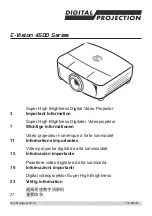
PicSight GigE Getting Started Guide, version 1.96.169.1
22
Note that the streaming with the reduced bandwidth need not have an impact to
the image data delivery if the transfer is still fast enough to transfer all the
image data before the next image is acquired. For example, if the camera is
triggered, and thus has long time gaps between frames, the increase of the
inter-packet delay can solve the problem without any side effects.
Another problem can occur when acquiring simultaneously from multiple
cameras connected to single NIC through a switch, namely if they are all
triggered at the same time. When the cameras start stream out the packets at
the same time, the switch must serialize the packets to one output line. The
capability of doing this depends on the switch internal construction and thus is
different for various manufacturers and models. The main factor influencing this
is the
size of the memory buffer
dedicated for each port. The higher is the
amount of the memory, the better.
For example, the 8-port switch has 144 kBytes of memory equally split between
the ports, so one port has 18 kBytes of memory. When using a
streaming
packet size
of 9 kBytes, only 2 packets fit to the buffer. In case 3 cameras
send a packet to the input ports at the same time, the switch must transfer 3
packets to the output port, and this (depending on the switch construction) can
fail due to the memory on the output port not capable to hold all 3 packets
(=27 kBytes). The solution in such case would be to use a smaller packet size,
for example 5.9 kBytes, so that all 3 packets fit in. Another problem can
happen, if the outgoing line is too slow to send out all the packets before new 3
packets come from the cameras; then it is necessary to reduce the bandwidth
by increasing the
inter-packet delay
, as already explained.
As mentioned, due to the internal construction of the switches, the capability of
the switches to manage such critical situations differs from switch to switch. See
the
Hardware Installation
chapter for list of switches which have been
successfully tested with PicSights.
4.4.2.
Packet Sizes
The size of the packets sent over the network can influence significantly the
effectiveness of sent data.
The Maximum Transmission Unit (MTU)
Represents the maximum amount of data that can be sent across an interface
without being broken up into more than one packet. The standard for Ethernet
network is 1500 bytes. Newer hardware implementations support so called
jumbo frames
which accept frames up to 16 kBytes.
The MTU has to be set on both sides to the same value, on the host (PC) side as
well as on the PicSight side Also, all devices along the network path from the
host to the client (switches etc.) must support the used frame size.
The Streaming Packet Size
Besides the MTU size setting, the
streaming packet size
can be set
independently. This setting determines the size of the streaming packets during
an image acquisition. This packet size must always be smaller than the MTU
size, and as this packet size does not include the header size for UDP/IP, it
should be always smaller by at least
50 bytes
than the MTU size. While the
MTU
represents the maximum possible size, the
streaming packet size
represents the
size actually used in the transmission.









































